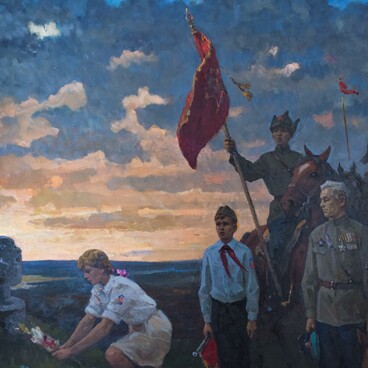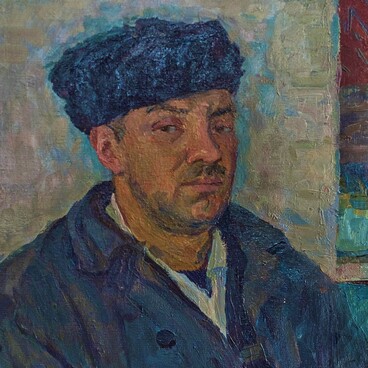The genre composition “Artists of the Vakhtangov Theater at the Dynamo Plant” by sculptor Igor Strelbitsky depicts artists Vasily Lanovoy, Yury Yakovlev, Mikhail Ulyanov, and Yulia Borisova, who were accepted as honorary members of the Communist Labor Brigade of the Dynamo Plant in Moscow.
The gypsym sculpture is a small model, but despite its size, the faces of the depicted people are executed in detail and with photographic precision; thus, the famous artists can be easily recognized.
Strelbitsky also placed a figure of an ordinary worker among the actors, as he wanted to show the closeness of the artists to the people. With this artistic solution, he asserts that all Soviet citizens are equal among themselves, be it a nationally beloved actor or a simple factory worker.
Strelbitsky made the model of gypsum. Gypsum, used in sculpture making, is produced from natural gypsum stone, a sedimentary rock that is a crystalline hydrate of calcium sulfate salt. To give the material the desired structure, gypsum stone is fired at temperatures ranging from 140 to 190 degrees Celsius.
Gypsum powder, mixed with water, hardens quickly, slightly increasing in volume from about 0.2 to 1%. It provides high precision in creating even the finest details. In addition, this material is inexpensive and easy to work with. Because of these properties, gypsum is considered the best material to remake a sculpture made of soft clay or plasticine into a solid working model.
For this, an artist, based on the original work, prepared a mold into which they subsequently poured gypsum which was previously mixed with water. Such sculpture was called a cast sculpture. Depending on the size, cast sculptures were either hollow or monolithic. For additional strength, they were often reinforced with hemp, metal, or wooden frames.
Igor Strelbitsky was born in 1924. He graduated from the Surikov State Art Institute in Moscow and studied in the workshop of sculptor Dmitry Shvarts. After the Institute, he began his artistic career as a member of sculptor Nikolai Tomsky’s team. His first assignment was to design the pavilion “Mechanization” at the Exhibition of Achievements of National Economy. Presently, this pavilion is called “Cosmos”.
Subsequently, Strelbitsky, with the same team, worked on sculptural compositions for the conference hall of the Palace of Culture and Science in Warsaw. In 1956–1977, he made several trips to the North Pole-4 drifting ice station and created an entire series of portraits of polar explorers. Many of the sculptor’s works are dedicated to the Great Patriotic War: “A Soldier’s Talk”, “The Last Pointer”, “Female Machine Gunner”. They are housed in the Central Armed Forces Museum.
The gypsym sculpture is a small model, but despite its size, the faces of the depicted people are executed in detail and with photographic precision; thus, the famous artists can be easily recognized.
Strelbitsky also placed a figure of an ordinary worker among the actors, as he wanted to show the closeness of the artists to the people. With this artistic solution, he asserts that all Soviet citizens are equal among themselves, be it a nationally beloved actor or a simple factory worker.
Strelbitsky made the model of gypsum. Gypsum, used in sculpture making, is produced from natural gypsum stone, a sedimentary rock that is a crystalline hydrate of calcium sulfate salt. To give the material the desired structure, gypsum stone is fired at temperatures ranging from 140 to 190 degrees Celsius.
Gypsum powder, mixed with water, hardens quickly, slightly increasing in volume from about 0.2 to 1%. It provides high precision in creating even the finest details. In addition, this material is inexpensive and easy to work with. Because of these properties, gypsum is considered the best material to remake a sculpture made of soft clay or plasticine into a solid working model.
For this, an artist, based on the original work, prepared a mold into which they subsequently poured gypsum which was previously mixed with water. Such sculpture was called a cast sculpture. Depending on the size, cast sculptures were either hollow or monolithic. For additional strength, they were often reinforced with hemp, metal, or wooden frames.
Igor Strelbitsky was born in 1924. He graduated from the Surikov State Art Institute in Moscow and studied in the workshop of sculptor Dmitry Shvarts. After the Institute, he began his artistic career as a member of sculptor Nikolai Tomsky’s team. His first assignment was to design the pavilion “Mechanization” at the Exhibition of Achievements of National Economy. Presently, this pavilion is called “Cosmos”.
Subsequently, Strelbitsky, with the same team, worked on sculptural compositions for the conference hall of the Palace of Culture and Science in Warsaw. In 1956–1977, he made several trips to the North Pole-4 drifting ice station and created an entire series of portraits of polar explorers. Many of the sculptor’s works are dedicated to the Great Patriotic War: “A Soldier’s Talk”, “The Last Pointer”, “Female Machine Gunner”. They are housed in the Central Armed Forces Museum.



